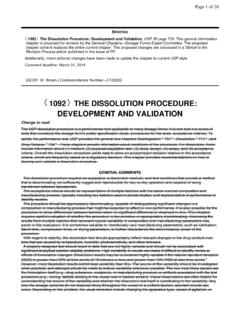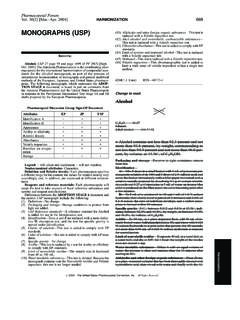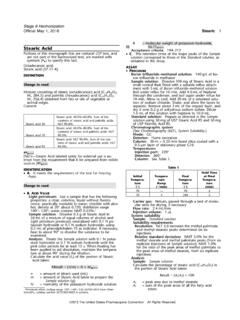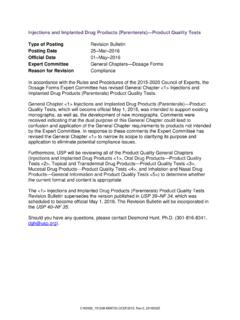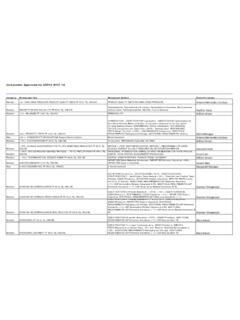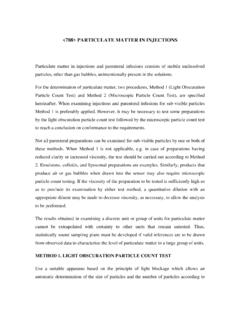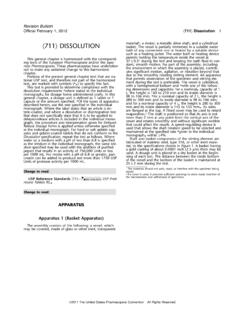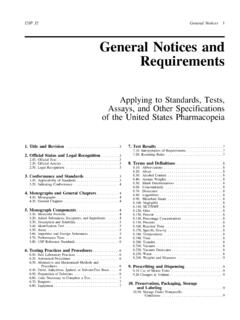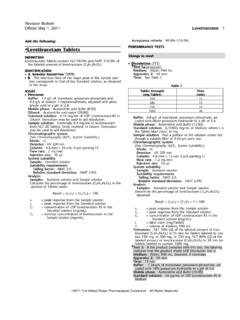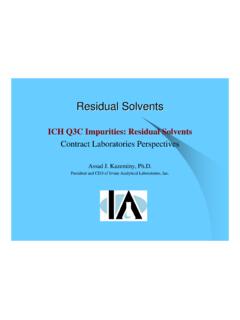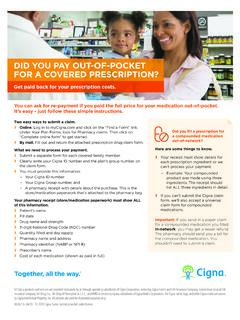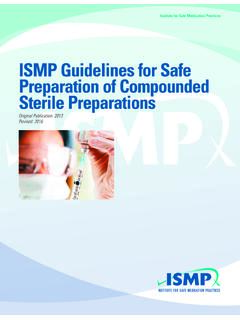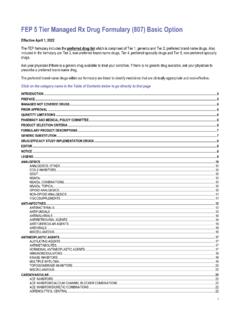Transcription of Labeling <7> Type of Posting Posting Date Official Date ...
1 Labeling <7>. Type of Posting Revision Bulletin Posting Date 30 Aug 2019. Official Date 01 Sep 2019. Expert Committee Nomenclature and Labeling Reason for Revision Compliance In accordance with the Rules and Procedures of the 2015 2020 Council of Experts, the Nomenclature and Labeling Expert Committee is issuing this Revision Bulletin related to Labeling <7> to address potential compliance issues resulting from the postponement of the Expiration Date and Beyond-Use Date section of the chapter. This Revision Bulletin clarifies that the Expiration Date and Beyond-Use Date section of General Chapter <7> that was Official prior to May 1, 2019, is still Official text in light of the postponement of revisions to this section. General chapter <7> has undergone several recent revisions, namely: Publication of an in-process revision as final approved text in USP 42 NF 37.
2 Issuance of a publication correction (see for details). Revision Bulletin postponing the Expiration Date and Beyond-Use Date section of the chapter pending further stakeholder input and revision, Official on May 1, 2019 (see for details). The Expiration Date and Beyond-Use Date section of <7> was postponed to facilitate further stakeholder engagement related to implementation challenges associated with the new requirement of a 4-digit year format for expiration dates. It was the intent of the Nomenclature and Labeling Expert Committee that the Expiration Date and Beyond-Use Date section of <7> that was Official prior to May 1, 2019, remain Official pending further revision of this section, upon issuance of the postponement. It is critical that this text remain Official in the interim, as it addresses several key compliance-related topics, including: 1.
3 Clearly describing the display of label text 2. Providing examples for expiration dates 3. Detailing how stakeholders should label products in the absence of an individual monograph requirement for Labeling 4. Providing for a 1-year beyond-use date for unit-dose (hospital) repackaged items, which has been in existence for many years Since issuing the postponement of the Expiration Date and Beyond-Use Date section of <7>, USP has received questions and comments that indicate confusion regarding the status of the currently Official text. This Revision Bulletin is being issued to clarify that the Expiration Date and Beyond-Use Date section of <7> that was Official prior to May 1, 2019, is still Official text in light of the postponement of revisions to this section. Future revisions to Expiration Date and Beyond-Use Date based on additional stakeholder engagement will be published as a proposed Interim Revision Announcement (IRA) in the Pharmacopeial Forum at a later date.
4 For any additional questions, please contact Misti Spann, Scientific Liaison (301-816-8585 or C234255-M4908-NL2015, rev. 00 20190830. Revision Bulletin 7 1. Official September 1, 2019. 7 Labeling . INTRODUCTION. This general chapter provides definitions and standards for Labeling of Official articles. Labeling standards for an article recognized in USP NF are expressed in the article's monograph and applicable general chapters. It is intended that all articles in USP or NF will be subject to the Labeling requirements specified in this chapter by means of a provision in General Notices, 10 Preservation, Packaging, Storage, and Labeling , unless different requirements are provided in a specific monograph. As with compendial standards for naming, identity, strength, quality, and purity, compendial requirements for Labeling have a role in the adulteration and misbranding provisions of federal law [see the Federal Food, Drug, and Cosmetic Act (FDCA) sections 501(b), 502(e)(3)(b), 502(g), and 502(h)].)
5 Exceptions or additional requirements specific to animal drug products and compounded preparations are provided in separate sections. Vaccine Labeling is not included in this general chapter. DEFINITIONS. The term Labeling includes all labels and other written, printed, or graphic matter on an article's immediate container or on, or in, any package or wrapper in which it is enclosed, except any outer shipping container. The term label is that part of the Labeling on the immediate container. A shipping container that contains a single article, unless the container also is essentially the immediate container or the outside of the consumer package, must be labeled with a minimum of product identification (except for controlled substances), lot number, expiration date, and conditions for storage and distribution.
6 Beyond-use dates (BUDs) and expiration dates are not the same. An expiration date identifies the time during which a conventionally manufactured product, active ingredient, or excipient can be expected to meet the requirements of a compendial monograph, if one exists, provided it is kept under the prescribed storage conditions. The expiration date limits the time during which the conventionally manufactured product, active pharmaceutical ingredient (API), or excipient may be dispensed or used. Expiration dates are assigned by manufacturers of conventionally manufactured products based on analytical and performance testing of the sterility, chemical and physical stability, and packaging integrity of the product. Expiration dates are specific for a particular formulation in its container and at stated exposure conditions of illumination and temperature.
7 The beyond-use date (BUD) is the date or time beyond which a compounded preparation must be discarded. The date or time is determined from the date the preparation was compounded . LABELS AND Labeling FOR DRUG PRODUCTS AND compounded PREPARATIONS. EXPRESSED AS ACTIVE MOIETY IN NAME AND STRENGTH. The names and strengths of drug products and compounded preparations formulated with a salt of an acid or base are to be expressed in terms of the active moiety on the label (see Nomenclature 1121 , Monograph Naming Policy for Salt Drug Substances in Drug Products and compounded Preparations). Labeling The Labeling clearly states the specific salt form of the active moiety that is present in the product or preparation because this information may be useful to practitioners and patients.
8 The names and strengths of both the active moiety and specific salt form (when applicable) are provided in the Labeling . Exceptions In rare cases in which the use of the specific salt form of the active moiety in the title provides vital information from a clinical perspective, an exception to this policy may be considered. In such cases, when the monograph title contains the specific salt form of the active moiety, the strength of the product or preparation is also expressed in terms of the specific salt form . LABELS AND Labeling FOR INJECTABLE PRODUCTS. The labels1 and the Labeling state the following information: Name of the product In the case of a liquid, the quantity or proportion of each active moiety or drug substance in a specified volume In the case of any product to which a diluent must be added before use, the quantity or proportion of each active moiety or drug substance, name and volume of diluent to be added, the concentration after the diluent is added, directions for proper storage of the constituted solution, and a BUD (see Expiration Date and Beyond-Use Date).
9 Route(s) of administration 1 If there are space limitations, see 21 CFR (i), 21 CFR (b), 21 CFR 2019 The United States Pharmacopeial Convention All Rights Reserved. C234255-M4908-NL2015, rev. 00 20190830. 2 7 Revision Bulletin Official September 1, 2019. Name and quantity or proportion of all inactive ingredients except ingredients added to adjust the pH or to make the drug isotonic may be declared by name with a statement of their effect; if the vehicle is Water for Injection it need not be named Statement of storage conditions Name and place of business of the manufacturer, packer, or distributor Identifying lot number and expiration date Rx only for human drugs The recommended or usual dosage. The container must be labeled so that a sufficient area of the container remains uncovered for its full length or circumference to permit inspection of the contents.
10 The lot number must be traceable to the complete manufacturing history of the specific package, including all manufacturing, filling, sterilizing, and Labeling operations. If the individual monograph permits varying concentrations of active moiety or drug substance in a large-volume injection (LVI), the concentration of each active moiety or drug substance named in the Official title is stated as if it were part of the Official title ( , 5% Dextrose Injection, or Dextrose Injection 5%, or 5% Dextrose and Sodium Chloride Injectionor Dextrose (5%) and Sodium Chloride ( ) Injection). Quantity and Total Volume for Injectable Drug Products Packaged in Single- and Multiple-Dose Containers For injectable drug products greater than 1 mL, whether packaged in single- or multiple-dose containers, the quantity per total volume should be the primary and prominent expression on the principal display panel of the label, followed in close proximity by quantity per milliliter enclosed by parentheses (quantity/mL).
